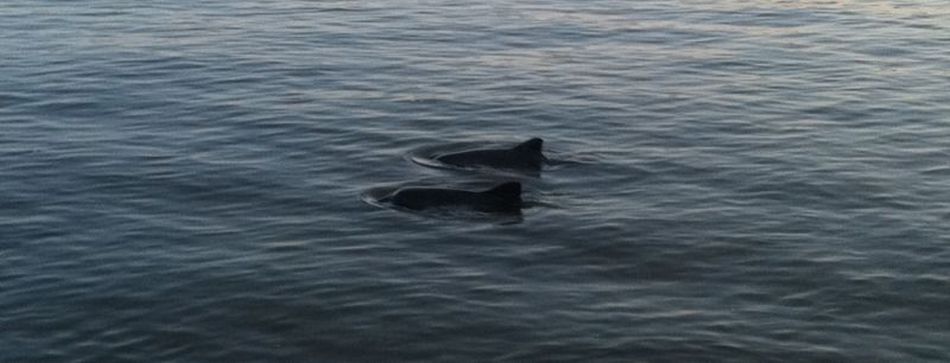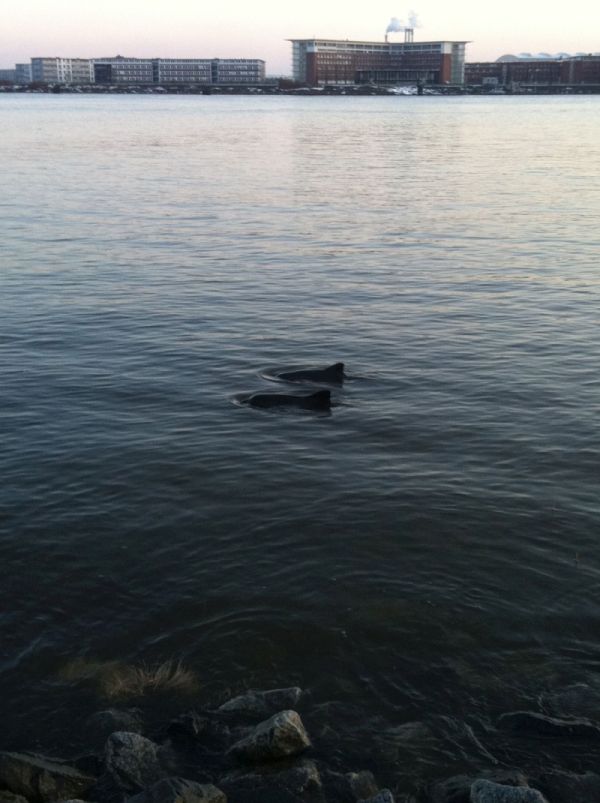
| Project data | |
|---|---|
| Project leader: | Prof. Prof. h. c. Dr. Ursula Siebert |
| Scientific work: | Denise Wenger |
| Cooperating institutes: |
Federal Agency for Nature Conservation (BfN) Waterways and Shipping Administration (WSA) Hamburg and Bremerhaven DW-ShipConsult GmbH, Schwentinental Hamburg State Institute for Hygiene and Environment Hamburg Agency for Urban Development and the Environment Hamburg Port Authority County Administration Wesermarsch University of Hamburg, Biocenter Grindel University of Liege |
Project description
Parts of the project are already done and data show the recent regular seasonal occurrences of harbour porpoises in the north German rivers Elbe and Weser during spring time when anadromous fish schools migrate upstream to their spawning grounds.
An opportunistic sightings scheme introduced in 2007 has shown the regular occurrence of harbour porpoises in the estuaries and lower courses of the Weser (Wenger & Koschinski 2012) and Elbe rivers up to the cities of Bremen and Hamburg during the months from March through June. The spatio-temporal pattern of the sightings corresponds to the pattern of the occurrence of anadromous fish species, especially smelt (Osmerus eperlanus) and twaite shad (Alosa fallax), swimming from the North Sea to their spawning grounds in the rivers. In 2010 and since 2013 acoustic data loggers (CPODs, Chelonia UK) were installed at different sites in Weser and Elbe. The CPOD data confirm the sighting data and seasonal appearance of harbor porpoises as well as foraging activity with click trains identified as foraging sequences.
Based on a first data analysis harbour porpoises must already be considered as part of the biocenosis of these rivers. In the major part, harbor porpoises have been seen swimming as single individual or duo, but also groups of five or more animals were recorded. In 2013, especially in Hamburg, numerous sightings were recorded and in the Hamburg port area whales have been observed hunting prey in groups with up to 10 individuals.
Also in 2013, 26 dead animals were found within a few weeks along the banks of the Elbe river in the stretch from the Hamburg port area to the cities of Wedel and Haseldorf. Compared to the numbers of dead found animals at the coast of the North Sea and Baltic Sea this is a relative high number in a short time so a systematic cause comes into consideration. The Elbe river as a high-traffic waterway and especially the Hamburg port is very different to the harbor porpoise habitats in the North and Baltic Sea, for example due to the intensely shipping traffic in a narrow river bed, the port basins and the regular use of echosounders for different measurements. The potential high anthropogenic underwater noise level may affect the harbour porpoises’ health and acoustic system.
Ambient sound pressure levels of the port environment and rivers are unknown. Harbour porpoises use their acoustic capabilities to navigate in their underwater environment and to locate and identify suitable prey which makes them highly susceptible to effects of manmade noise (Ketten et al. 2000, Verfuß et al. 2005). The effects can range from masking the whales’ ultrasound signals for communication or foraging or mild disturbance to auditory impairment, temporary or permanent auditory threshold shifts, hearing loss and even death (Richardson et al. 1995, Southall et al. 2007). Therefore passive measurements of sound pressure level are highly recommended (Merchant et al. 2013; Sousa-Lima et al. 2013).
Fast watercraft also may pose a threat. Some cases of evidence suggest ship strikes as cause of death.
In the future, within the frame of the project and according to the EU Habitats Directive, scientific necropsies of all animals found dead will be done to obtain information about the causes of death, health status, effects of anthropogenic underwater noise, contamination burdens, age structure, reproduction status and population genetics.
Aims of the project
- Determination of the abundance and spatial-temporal distribution of harbour porpoises frequenting the rivers, their foraging sites, group structures and performance of behavioural studies
- Measurements of ambient sound pressure levels in the Hamburg port environment and examination of the impact on harbour porpoises
- Examination of all dead found whales and determination of cause of death, health status, diseases, pollutant levels, stomach content (determination of prey species), genetics
- Identification of threats and data analysis as basis for the implementation of monitoring and conservation measures in the Elbe and Weser river estuaries and lower courses for a better protection of this species listed on Appendix II and IV under the EU Habitats Directive (Natura 2000).
- The project has been registered as a dissertation at the University of Veterinary Medicine Hannover, Foundation.

Contact person
Stiftung Tierärztliche Hochschule Hannover
Institute for Terrestrial and Aquatic Wildlife Research
Werftstr. 6
25761 Büsum
Denise Wenger


